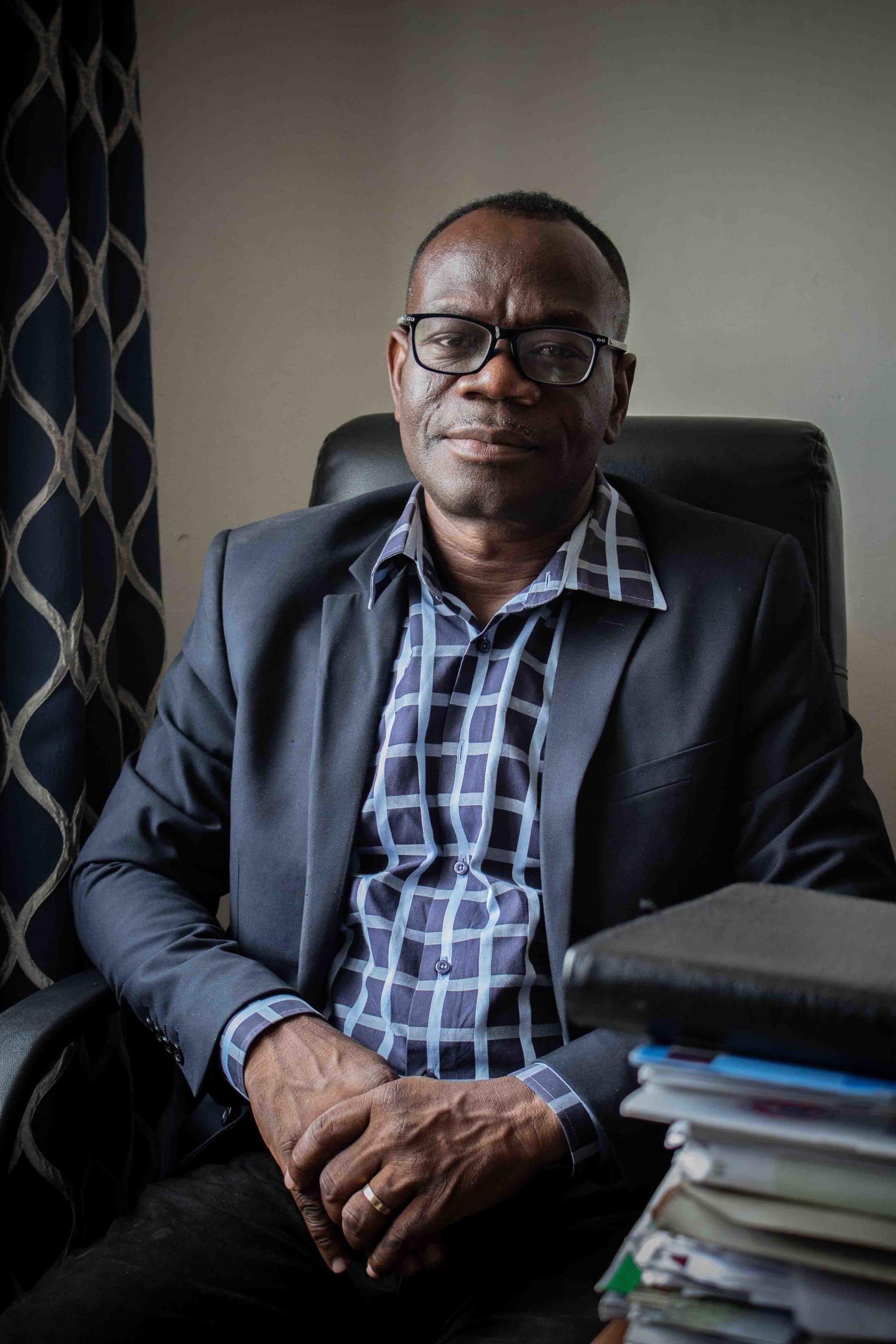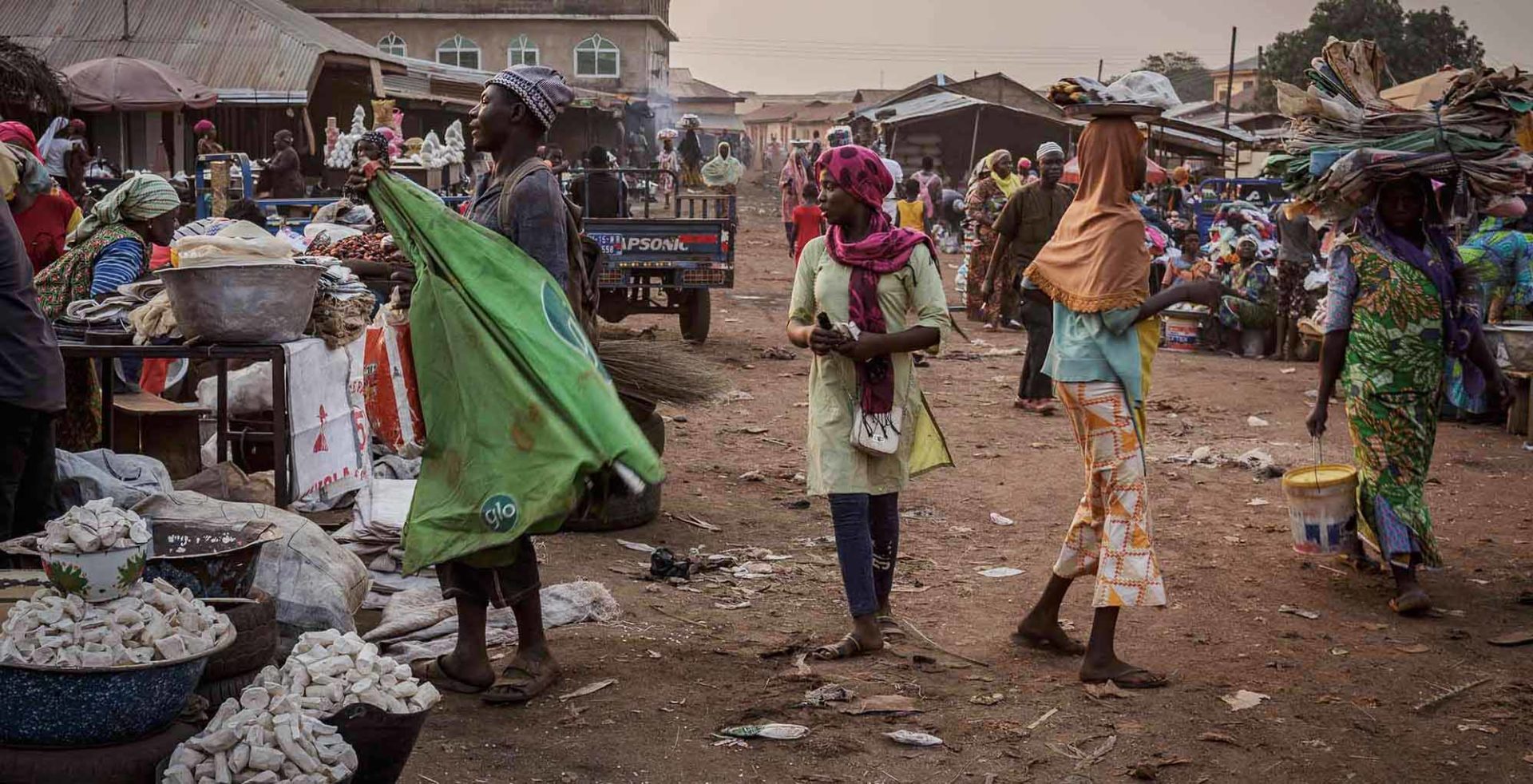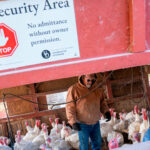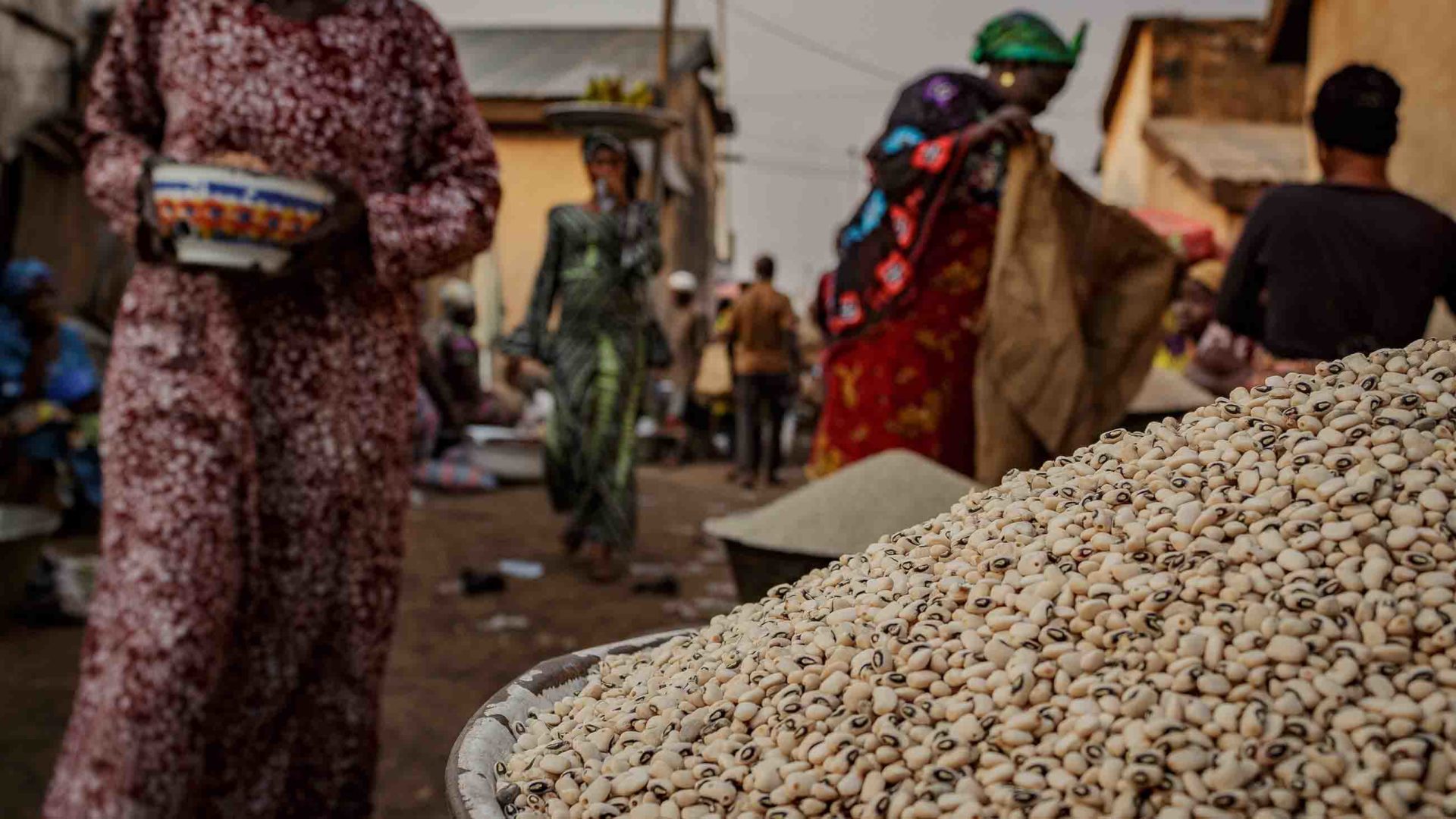In Ghana, a Bumper Crop of Opinions on Genetically Modified Cowpea
Under the noonday sun, Alimatu Alidu uses a stone to grind tomato, red pepper, and small crayfish into a red paste. Drops of sweat collect on her forehead, just below her black headscarf. She adds the paste along with other ingredients into a cooking pot balanced upon a make-shift stove, consisting of two uneven rocks with a small fire burning between them. Once her mixture is sufficiently heated, she adds the final element: boiled cowpea beans. Known as poor people’s meat, these faded yellow legumes with a big black dot along the curve are ubiquitous throughout West Africa, including here in Ghana.
 This story was supported by the Pulitzer Center.
This story was supported by the Pulitzer Center.
Other days, Alidu prepares cowpea fritters, or koose, whipping ground cowpea and water into a batter, adding spices, then frying individually-rolled balls to be served for breakfast. She can make five different dishes from cowpea beans, which grow inside green pods up to 12 inches long.
Soon the spicy dish known as red-red is fully cooked and ready for Alidu’s 16-person family, which includes herself, her husband, their six children, and her husband’s second wife and their seven children. Together, they live in thatch huts that surround this open-air kitchen in the northern village of Zinindo.
Cowpea is a staple in Ghana and other parts of West Africa, where it is believed to have first been domesticated. The legume is a favorite among farmers and laborers, who consume it in the morning before leaving for work and don’t feel hungry until sundown. At her doctor’s request, Alidu increased her own consumption when she was pregnant, and she used the ground seeds to wean her children. Cowpea is a mainstay of school lunches in Ghana. And because the crop can be harvested within two months of sowing, it fills the “hunger gap” for poor families between May and August when other crops, such as maize, are still young in the field. And cowpea tolerates droughts, which are increasing across sub-Saharan Africa. Every woman in Zinindo keeps some cowpea in her home, says Alidu.
But cowpea has been under attack for years. A winged pest, Maruca vitrata, bores into the pods and nibbles away at the seeds, destroying anywhere between 20 and 80 percent of West Africa’s cowpea crops every year. In response, scientists have genetically modified cowpea plant lines to resist the pest, and advocates for the technology — which involves altering an organism’s DNA in ways that aren’t possible through traditional breeding — believe that genetically modified (GM) cowpea can help feed the fast-growing population on a warming planet. It can also help reduce the use of pesticides, they say, freeing up land for other uses, providing enough surplus for regional market opportunities, and giving farmers an additional choice about what to grow.
Ghana plans to release GM cowpea sometime this year or next, which would make it the third sub-Saharan African country after South Africa and Nigeria to approve local production and sale of GM food.
What worries some critics is that all of Africa’s genetic modification projects are closely tied to Western organizations. Licenses for the patented genes that African scientists use to modify cowpea crops, for example, were provided royalty-free by biotech companies such as Monsanto (since acquired by Bayer) — inviting questions about whether their goals are purely humanitarian. Further, social scientists warn that GM seeds are being pushed by international donors without fully taking into account the agriculture practices of poor farmers and the specific crop characteristics that they most want and need. While some African scientists are working tirelessly to reassure laypeople that GM foods are safe, it’s clear that safety concerns, however unfounded, are not the only challenge standing in the way of GM cowpea in Ghana.
Here in this rural village, Alidu and other poor farmers have not been following these controversies. But they say they are open to new approaches that would minimize pests, allowing them to grow enough cowpea to feed their families with a surplus to sell.

The roots of GM cowpea date back to the 1990s, when the Rockefeller Foundation, a New-York based philanthropy, entered into a series of conversations with companies that own many of the genes used to modify food, including Monsanto, DuPont, and Syngenta. Staff at the Rockefeller Foundation believed that biotechnology could help poor countries grow more food. But they understood the companies were unlikely to invest in genetically modifying so-called orphan crops such as cowpea, cooking banana, and cassava, which aren’t traded internationally and are often grown and eaten by farmers without the financial means to purchase expensive GM seeds.
Staff at the Rockefeller Foundation proposed that the companies donate the genes to research institutes in developing countries. Researchers at those institutes would then use the genes to develop seeds for orphan crops that could resist pests, tolerate drought and excess salt, and enhance nutrition. A humanitarian organization would be created specifically to facilitate a partnership between the companies, philanthropic and governmental organizations, and the local scientists.
The companies initially rejected the proposal, but ultimately accepted the plan after internal discussions about how the partnership could restore their public image. Across the globe, the anti-GM movement had accused the biotech industry of monopolizing the world’s seed supply. Amid this and other criticisms, the companies agreed to an alliance.

Richard Ampadu-Ameyaw, Ghana’s coordinator for the Open Forum on Agricultural Biotechnology in Africa, believes that training journalists and farming leaders about the science of GM food is the best way to dispel myths around it.
But they had conditions. The biotech companies wanted Asia and Latin America “off the table” because business was thriving in these regions. The companies also wanted strict licensing contracts that specified where, when, and to whom they would make the genes available royalty-free. These historical details were published in a paper by University of Minnesota sociologist Rachel Schurman, who had interviewed employees of the Rockefeller Foundation, biotech companies, and scientists in Africa.
The Rockefeller Foundation agreed to these terms and soon found an additional partner — the United States Agency for International Development (USAID), which at that time was also trying to bridge partnerships between U.S. universities, biotech companies, and research institutions in developing countries to increase the global acceptance of biotech products. USAID representatives say that their agency promotes biotechnology when conventional breeding is too slow or ineffective to improve a given crop.
Over time, other big donors such as UK Aid, and corporations such as PepsiCo, joined the coalition. These groups reached out to African scientists, many of whom believe that biotechnology can solve some of African agriculture’s problems. In 2004, the African Agricultural Technology Foundation was launched. This Nairobi-based nonprofit now coordinates many of the GM research projects in sub-Saharan Africa. Two years later, it formed the Open Forum on Agricultural Biotechnology in Africa (OFAB), an advocacy arm tasked with changing the public’s negative perception of GM products. Today, with financial support from the Bill and Melinda Gates Foundation, OFAB organizes meetings between scientists, farmers, and the media.
In Ghana, supporters of GM cowpea welcome Western support and believe the international partnerships serve the interests of local farmers. Anti-GM groups, however, don’t trust the companies or their technology. “There is no free lunch,” says Edwin Kweku Andoh Baffour, a spokesperson for Food Sovereignty Ghana, the most active anti-GM group in the country.
For now, OFAB appears to be making inroads. A number of Ghanian journalists said that after attending its workshops, they felt better equipped to address misconceptions. For example, doctored images of animal-shaped fruits — supposedly created by inserting animal genes into fruit seeds — had been making the rounds on social media.
“More scientists are coming forward to change public perception,” says Joseph Opoku Gakpo, an Accra-based journalist who has attended GM workshops.
One day in January, Alidu joins a small group in a prayer led by an old man under a grass-thatched shed near her house. After the prayer is finished, the old man introduces Mohammed Adams Nashiru, head of a farmers’ group in the region. Ghanian scientists have improved cowpea to fight off one of its pests, explains Nashiru. This could benefit local farmers, some of whom see half their cowpea destroyed by field pests in a given year. With this new cowpea, farmers will be able to grow more using less insecticide.
Alidu is skeptical. For one, she and some of Zinindo’s farmers already intercrop cowpea, which lessens pest infestation. Further, though the farmers’ group leader assures the group that the seeds will be available soon, he is one of many government officials, traders, and researchers who have visited the village with promises to improve farmers’ lives. According to Alidu, none of them have ever returned.

In stark contrast to his work today, roughly three years ago, Nashiru was leading marches in northern Ghana against GM crops. He says he had a change of heart in 2014 at an OFAB workshop where Walter Sandow Alhassan — former head of Ghana’s Council for Scientific and Industrial Research — told an audience of farmers and journalists that GM food has been rigorously tested and is safe to eat. People in the United States, he noted, have been eating genetically modified food for many years. “He said that nothing happened to them,” says Nashiru. “There is no need to worry.”
Two years later, a report by the National Academies of Science, Engineering, and Medicine concluded that there is “no substantiated evidence” that GM crops are less safe than non-GM crops.
Although scientists and the OFAB are working to get that message out — with some scientists even asking their pastors to let them speak about GM food after Sunday prayers — changing public perception “is extremely challenging,” says Vivian Oduro, a plant scientist with the Biotechnology and Nuclear Agriculture Research Institute in Accra.
In Ghana, the debate around GM food is highly polarized, as it is elsewhere in the world, even in the U.S., where resistance has paralleled a growing demand for organic foods and clear labeling of genetically modified products. “This is a very connected movement,” says Mark Lynas, a former anti-GM activist turned science writer. “I often see European and U.S. themes quickly picked up by anti-GM activists in Africa.” But Lynas also notes that as people are exposed to a wider variety of facts and opinions — beyond the simple anti-GM narrative — their own views tend to become less entrenched. Many now say they don’t know enough about the technology to be for or against it.
Oduro remembers a debate organized by a government ministry in Accra last year, where the audience was asked to vote on the introduction of GM foods. After Oduro explained the science of genetic modification, a different speaker quoted a controversial 2012 study by French scientist Gilles-Éric Séralini. The study showed Séralini’s lab rats developed cancer after eating GM corn. (The paper was retracted the following year after a review found that “the conclusions described in the article were unreliable.”) The speaker also announced that waakye, a popular cowpea delicacy slow cooked with rice, would be made using that same technology.
That made Oduro furious. In her next turn to speak, she appealed to the audience as a fellow Ghanaian and as the daughter of a farmer. She and her family eat cowpea, she said. Why would she promote something she believed to be harmful?
In fact, experiments show that GM cowpea is not just safe, it also yields about .85 tons more per acre than conventional varieties. And although the GM seeds will be about 50 percent more expensive than conventional seeds according to one estimate, they will require just two rounds of pesticides, rather than the current five to six. That will cut overall production costs by 5 to 10 percent.
But, says Oduro, once someone has stirred up fear, it is difficult to convince people not to be afraid. That day, the audience voted against genetically modified crops.

Entomologist and principal investigator on the GM cowpea project Mumuni Abudulai often reaches out to journalists asking them to call him whenever they are doing a story about GM food.
A couple days later, the aggregated online news site GhanaWeb posted an article about Oduro’s public statements. In the comments section, somebody called Oduro a “dirty bitch.” Someone else called her a “foolish woman.” Alhassan has even been the target of online death threats. In 2015, an Accra-based newspaper ran an article that quoted him saying genetically modified food is safe. “Shoot alhassan on the throat. IDIOT!” wrote one commenter after the article was posted on GhanaWeb. “Prof. Walter Sandow Alhassan must die now,” wrote another.
Baffour, the spokesperson for Food Sovereignty Ghana, says that he doesn’t believe studies such as the ones analyzed in the National Academies of Science, Engineering, and Medicine report. He maintains that other studies show GM crops are not safe because they have “unintended risks” though when questioned didn’t explain what those risks might be. And when asked for examples, he was not able to provide any that were published in peer reviewed journals.
According to Baffour, organic food is “natural” and “obviously the future of the world.” Organic food, however, is expensive to grow because it requires more labor and costly herbal insecticides, which farmers like Alidu cannot afford. This is why biotech scientists say it’s best to offer choices and let farmers decide which seeds best meet their needs.
Anti-GM marches have occurred across Ghana, with many of them centered in Accra. But Nashiru characterizes the marches as a “show for media.” When he used to help organize them, he says he would call village farmers, hand them placards they couldn’t read, and pay them for their efforts. The farmers didn’t even know what they were marching for.
Interviews with a wide range of Ghanaians revealed some reservations about genetically modified foods. Wouldn’t there be something wrong, they wondered, with a crop that even insects won’t eat? Some maintained that the foods looked “too clean,” though few had actually seen these foods.

Richard Ampadu-Ameyaw, Ghana coordinator for OFAB, thinks it is best to train leaders like Nashiru whose community ties and farming background lend him credibility in the eyes of local community members. Yet there are notable differences between Nashiru’s life and the lives of the poor farmers. For one, he has travelled internationally. He also owns 250 acres of land, much more than a farmer like Alidu, who owns just five acres.
For his part, Nashiru says he cares deeply about the seeds poor farmers ultimately use. “My grandfather told me that monuments are not built after rich people,” he says. They are built to commemorate individuals who improve the lives of the whole community. “This is the type I want.”
On a hot morning, Alidu opens one of the plastic bags in which she stores her cowpea beans to discover tiny brown weevils — a type of beetle — scurrying around inside. They have bored neat holes into the seeds. Before cooking, Alidu will have to put the cowpea in a pot and cover it with water so that the weevils float to the surface, where they can be seen and removed. She cannot sell this cowpea in the market, even if there is surplus at home.
Farmers in Zinindo are as troubled by weevil attacks on stored cowpea as they are by pests in the field. Yet the African Agricultural Technology Foundation does not yet have a project to address this problem.
“These [GM] technologies are being privileged at the expense of other potential interventions,” says Matthew Schnurr, a professor at Dalhousie University in Canada. Schnurr has been researching GM orphan crop projects in Africa for over a decade. He says it doesn’t make sense to introduce the crops without solving other problems, such as storage, in the agricultural supply chain.
GM cowpea’s main donor, USAID, does work to solve supply-chain issues for maize, rice, and soybean in Ghana. But it does not yet have a clear plan for how to reduce post-harvest losses for cowpea.
Some people, including Charles Kwowe Nyaaba of the Peasant Farmers Association of Ghana, question whether GM cowpea is even necessary, given that Ghana already grows enough cowpea to feed its population. He wants the government and international aid organizations to use their money to build storage facilities, subsidize seeds and farm equipment, and create more demand for cowpea. Otherwise, overproduction could lead to price declines in local markets and the crop could rot in the field.

In fact, cowpea is one of the few food crops in Ghana not currently being processed for use in other products, says Irene Egyir, an agricultural economist at the University of Ghana. Sorghum, for example, is bought by breweries to make beer. If cowpea were similarly industrialized, says Egyir, this would increase demand and likely help cowpea farmers earn more money.
Distribution is also a problem. About 90 percent of Ghana’s cowpea is grown in the north, and while there’s unmet demand for cowpea farther south, bad roads and lack of storage, among other factors, have deterred traders, says Nyaaba.
In response to these criticisms, USAID and biotech scientists have argued that that there is no reason to pit one problem against the other. African Agricultural Technology Foundation officials have said they will work on reducing post-harvest losses in coming years.
Still, some social scientists doubt GM orphan crops will benefit poor farmers, even if the supply chain is improved. They say there is a gulf between these research projects and the specific needs of small farmers. Schnurr’s research on cooking banana, a staple food in Uganda, provides a case in point.
Traditional cooking banana is low in vitamin A, and almost half of children in sub-Saharan Africa are vitamin-A deficient. This makes them prone to diseases and blindness. So scientists are genetically modifying a banana to increase Vitamin A levels. But this particular variety will require farmers to apply more fertilizer and maintain specific sowing space. This could prove a barrier to poor farmers, who can’t afford additional fertilizer and have limited land. For these reasons, some poor farmers in Uganda may continue to plant their preferred traditional cooking banana varieties, which are not amenable to genetic modification. Schnurr says scientists should have first spoken to farmers to assess how many of them would grow genetically modified cooking banana.

“The donors and scientists probably have good intentions, and they want to help,” says Klara Fischer, an associate professor of rural development at the Swedish University of Agriculture Sciences. “But they are not doing enough groundwork with an open mindset.”
Fischer’s research in South Africa indicates that its GM maize, which resists a common pest that bores into the stalk of the plant, poses a challenge to poor farmers in particular because non-subsidized seeds are expensive and the crops require regular watering as well as synthetic fertilizers. While large-scale farmers can pay for fertilizer and have access to running water, poor farmers depend on rains, which sometimes come late. “The problem was that they wanted the small holder farmers to have the most modern maize,” says Fischer. “But the most modern maize was suited to a completely different kind of agriculture system.”
Still, Songotra — the cowpea variety that has been genetically modified — is already grown in about 20 percent of the cultivated area of Ghana’s Northern Region, and it is one of the varieties preferred by subsistence farmers. According to Mumuni Abudulai, principal investigator for the Bt cowpea project in Ghana, GM cowpea would not require poor farmers to do anything additional except maintain refuge — a practice in which non-GM crops are planted around GM crops making it more difficult for pests to develop resistance to the genes in GM crops. Whether the farmers will adequately maintain this practice, however, is not yet clear.
Both Schnurr and Brian Dowd-Uribe, an associate professor at the University of San Francisco who is researching a GM cowpea project in Burkina Faso, are concerned that orphan crop projects are likely to perpetuate the old agriculture development pattern which benefits rich farmers first and to a greater extent than the poor ones. Rich farmers are mostly literate, understand technology, and can afford risks. Sometimes poor farmers follow their lead after seeing the technology work. But “the goal of these projects is focused on small farmers,” says Schnurr. He believes the projects should be course-corrected to benefit them first instead of asking them to play catch up.
In other parts of the world, there is some evidence that genetically modified crops can help small farmers. A recent study from Bangladesh found that farmers who grew GM eggplant earned six times more per acre than those who grew conventional eggplant. In India, where GM food crops are not yet permitted, some farmers have started growing GM eggplant illegally because they believe it is less costly to grow.
Schnurr’s research has ruffled the feathers of some agriculture scientists in Africa. In an email shared with Undark, a Kenyan scientist cautioned his colleagues against meeting Schnurr, whom he feared could be peddling anti-GM propaganda.

The debate around genetically modified food in Africa is so polarized, says Schnurr, that there is little room for questioning on either side.
According to recent estimates, if GM cowpea is released next year, it will take five to 10 years for it to reach the projected maximum adoption rate of about 70 percent of farmers because of the negative perception surrounding GM foods. And yet, before Nashiru’s visit to Zinindo, many of the local farmers had never even heard of genetic modification. Some soon forgot the term, though they remembered that there is a technology that enables their cowpea to resist pests in the field. That, they said, is a good thing.
But because none of Zinindo’s farmers had actually grown GM cowpea, it was difficult for them to say anything more. Any concerns with the new technology had not yet reached them.
In some ways, this would appear to represent a small but important victory for proponents of Ghana’s GM cowpea, who have struggled to be heard above the voices of anti-GM activists. But whether the seeds will truly benefit small farmers like Alidu and her family — that remains an open question.
Ankur Paliwal is an independent science journalist. He currently lives in New Delhi.











Comments are automatically closed one year after article publication. Archived comments are below.
I just want to say thank you for one of the best, even-keeled pieces on GE foods I’ve ever read. And I have read a LOT of them over the years.
Dear Mr Ankur Paliwal
Thank you for writing a very balanced article on GM cow-pea. You vividly described the trials and tribulations faced by the poor farmers..There can be perceptible positive changes in their approach only if the leaders in their local community come forward to assist them with all types of support and help. For lasting, consistent progress in such endeavors there must be dedicated voluntary organizations preferably with the support of the governmental agencies.
Will the pests adapt over time to the modification? If so, how long will it take for this to be a serious problem?
Improved yields, reduced pesticide, and better profits for farmers? I hope that quality information gets to those who need it.
People complain that regional and cultural crops aren’t supported by the companies. Then when a crop is developed by the regional folks, people complain about that. ¯\_(ツ)_/¯
I wonder what the mythical crop looks like that has the best characteristics, with perfect pedigree, and where that has to come from to be acceptable. And if it exists, why isn’t it in farmers’ hands now? I assume it would also fix all the problems of distribution, storage, roads, and other barriers. Because of course it would be expected to carry all the weight.
If only the folks dragging the scientists would spend their time and money on these mythical bounties instead of harassing scientists and science communicators, maybe we’d make progress.
As a member of the Scientific Advisory Board of the Alliance for Science, I met some great Ghanans who are working to get the best information out to their community. I hope they succeed, and stay safe.
Scientists are doing a great job in telling people benefits of the crops they have developed. But that alone is not going to help. The crop would exist/live in a social system and better efforts need to be made to understand those systems. And it would take not just biotech scientists but governments, farmers and economists and social scientists to work together to make the crop work for farmers it has been designed for. So the weight of the problems is to be shared and nobody is asking the crop to carry all the weight.